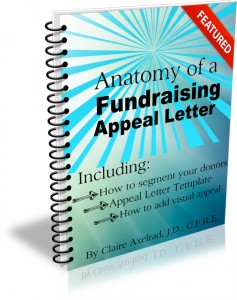 Are you starting to worry about whether you’ll raise enough money this year to meet your goals? Are you concerned because last year’s appeal didn’t raise as much as you had hoped? Are you fresh out of ideas for what to put into an appeal to generate the giving response you need to sustain vital programs? Fear not! Help is on the way! Just use this 24-point checklist before you send anything to your printer.
Are you starting to worry about whether you’ll raise enough money this year to meet your goals? Are you concerned because last year’s appeal didn’t raise as much as you had hoped? Are you fresh out of ideas for what to put into an appeal to generate the giving response you need to sustain vital programs? Fear not! Help is on the way! Just use this 24-point checklist before you send anything to your printer.
Annual Appeal: Tried-and-True Secrets for Success
Crafting fundraising appeals is not rocket science, but you do have to adhere to certain guidelines if you want to achieve blast-off. These are simple, tested and true. They won’t let you down.
- Begin with a problem your donor can, and wants to, solve. Unless you describe something compelling that resonates with your reader, you’re sunk before you’ve begun.
NOTE: A problem is not something you’ve already solved. “Last year we helped 3,000 homeless people stay off the streets” isn’t compelling because the solution has already been found. Try “3,000 people in our community will have no shelter, food or clothing this winter, unless you help.” Your goal is not to evoke an “oh, that’s nice.” Rather, you must strive to evoke an “oh my, that’s absolutely terrible – what can I do to help?”
- Be clear what solution you’re offering, and why you’re uniquely suited to do so. What does your organization do differently, and especially well? Begin with a problem the donor can solve; offer a solution they’ll believe.
NOTE: “Your $25 will cure cancer” may not make much sense. But “Your $25 offers a relaxing massage at our one-of-a-kind cancer health center to someone dealing with the pain of chronic illness” is something people can visualize and wrap their brains around.
- Be emotional. Your readers don’t care about facts as much as they care about drama. Give your readers a reward for reading. It’s important to always keep in mind that heart trumps mind. One of the key insights discovered in the commercial world is that emotionally satisfied customers are substantially more profitable than rationally satisfied or dissatisfied customers. Help them to feel something that will motivate them to act.
NOTE: Use descriptive language that paints a picture that draws people into the story. Humans are wired for stories, so work with that innate wiring!Also see #18 below.
- Instill trust; demonstrate you’ll be a good investment. If you have any accreditations or awards (such as a Guidestar 4-star rating or Better Business Bureau) it’s great to subtly include this on the letterhead. Or sometimes simply listing the board on your letterhead can accomplish this. Lift notes from influential supporters can help too.
NOTE: Consider including testimonials from clients, donors, influencers or community leaders. People are more inclined to believe what others say about you than what you say about yourself. It’s one of Robert Cialdini’s Principles of Persuasions, known as social proof. Finally, letting readers know how many people you helped last year is a good idea. Just don’t overdo it on the numbers and statistics; they should simply supplement the story or stories you tell about individual people.
- Include a clear, upfront compelling call to action. What exactly do you want your donor to do? Just remember: you aren’t asking for money because you want money. Or because your organization wants to grow. You’re asking for a specific amount to implement a specific solution. Help the reader understand the scope of the dollars required to implement the solution.
NOTE: If they give $100, what will that accomplish? What happens if they give $1,000? Relatively few donors today give because it’s the right thing to do. Most donors give to achieve results.
- Don’t pussyfoot. Ask in the first few paragraphs. Sure you can, and should, ask again at the end. But don’t wait that long. People skim. You never know when or where your reader will see your ask. So increase your chances.
NOTE: Whatever you do, don’t bury your ask in what Jeff Brooks of Future Fundraising Now calls the dead zone (the upper to middle paragraphs of the last page of your letter).
- Take advantage of the P.S. This is often the second thing the reader looks at, after the salutation. 90% read the P.S. first according to oft-quoted research from Professor Siegfried Vogel’s eye-tracking studies. It’s a good place to summarize a key point in the letter.
NOTE: One tip is to write your letter; then take a good look at it and pull out your most important message and move it to the P.S. to assure it’s seen. You can also keep it in the body of the letter (using slightly different wording, of course, so you don’t bore your readers to death). When it comes to your key message, repetition is a good thing. It could be the reason why you’re asking for a gift now. It could be the specific amount/project for which you’re asking. It should be specific and compelling and speak to why a donor would want to invest with you right away.
- Create a sense of urgency. Why must the donor give NOW? Give some real thought to this.
NOTE: Before you finalize your appeal, show it to someone outside you organization. Ask them: “Is there anything about this that makes you want to give right now, rather than putting this aside to think about later?” “What would it take to get you to act with urgency?”
- Entice people to read the important parts of the letter. Good direct mail is designed to be skimmed. Eye motion studies show most folks read in a particular pattern from upper right to the salutation… to the signature (which is why who signs the letter is important – who’s signing it?)… to the P.S…. then back up to any illustrations… then to the subheads… then to the bullets and underlines… then, if you’re lucky, to the entire letter.
- Show gratitude. If your donor has given before, remind them. Show them your appreciation. Tell them they made an impact. People are inclined to repeat their past behaviors.
NOTE: Remind former donors they gave in the past. This is a shortcut to decision making for them now. If this is a prospective donor, thank them in advance. Flatter them by assuming they are caring and generous. People want to act on their finer qualities and better nature.
- Use “You” instead of “I”. “You” and “your” are emotional triggers. The letter should be about the donor and what they will accomplish through their investment. It’s not about how wonderful you and your organization are. The donor must feel they are vitally important.
NOTE:This is especially important in the opening paragraph where you want to draw the reader in. It has to be about them from the get-go..
- Use conversational English. This means short sentences (no more than 10 words) and paragraphs (no more than four to seven lines), contractions, conjunctions at the beginning of sentences, prepositions at the end of sentences, action verbs, not too many adjectives and adverbs and fragments.
NOTE: Read your letter aloud. If it sounds stilted, rewrite.
- Avoid “organization–speak”, jargon or labels. Always think from the perspective of the reader. You use words like “clients” and “caseworkers”; your readers don’t. Maybe everyone who works where you work has a PhD and is a stickler for grammar. Your readers aren’t. Maybe you love learning a great big new word every day, then figuring out ways to use it. Your readers won’t.
NOTE: Keep it simple. Write at no more than a 4th to 6th grade level. It’s not “talking down” to people. It’s simply what most people will comprehend given the time they’ll likely devote to reading your appeal.
- Include sub-heads, bullets, bold face, italics, underlining and indented paragraphs to break up copy and call attention to key points. Most people don’t start at the beginning and read straight through to the end. If they read just the headline, they should get the gist. Just the boldface? They should get the gist. Just the italics? They should get the gist.
NOTE: I like to write letters, within letters, within letters. See what you understand if you read just the bold face…just the underlines… just the italics.
- Use simple, legible fonts. I know you know that serif fonts are best for text (e.g., Courier, Garamond or Times Roman); sans serif is best for headlines and sub-heads. But did you know 14 point text is now recommended given the graying of our population?
NOTE: Keep in mind a good 50% of people will read online appeals on their phones. Don’t make them squint or, worse yet, click away telling themselves they’ll come back to it later on the computer. Later often never comes.
- Indent paragraphs. Not only is this a friendlier style (something I learned in middle school typing class), it also invites the readers into your copy and gives their eyes another little rest. Our brains use indents in “pattern recognition.” Pattern recognition is important to keep reading speedy. And, remember, your reader has no time.
- Use black or dark blue on white paper. You want the letter to be easy on the eyes.
NOTE: It’s okay to use bits of color for highlights or headlines. And the carrier envelope can certainly be a bright color so it stands out in the mail. Just don’t become over-enamored of design in the body of the appeal.
- Take advantage of a compelling photo or photos. A picture (with a caption) truly is worth 1,000 words. And, remember, most people skim.
NOTE: While there is division on the subject of whether happy or sad photos work better, I’m a fan of sad or neutral photos for appeals (the problem is not yet solved) and happy photos for thank you letters and reports (the problem has been addressed, with the donor’s help). Of course, this is something you can test for your organization.
- Add a hand-written note. Hoping this is part of your plan! I’ve found this to boost returns from as little as 2% to 20% or more with current donors. Ask board members, volunteers and staff to review your lists and agree to take on assignments.
NOTE: Keep a record of the folks who write notes so you can make them similar assignments next year. This way your notewriting program will grow over time and you won’t have to start all over again every year.
Guidelines for Your Remit Piece:
Your reply device is an in-a-nutshell mini-appeal. Everything your donor really needs to know should be included here. Why? Often folks throw out the letter and save the response piece for later. When they come back to it, it better inspire them to follow through on their good intentions!
- Include a compelling photo that tells your story. Headshots are usually the best; people relate best to one person who needs help. Try to repeat a photo from your appeal letter so the package fits together as a whole.
- Restate the theme/thesis of the appeal.
NOTE: People who save remit pieces to deal with later often don’t save the appeals that accompanied them. Accordingly, you must make your case — again — on the remit. Otherwise, they’re apt to throw it out wondering “why did I save this?”
- Make a clear ask for a specific amount (or range) that is within the realm of possibility (or sensibility) for this prospective donor. Ideally you’d have two separate remits, one for lower-end and one for higher-end prospects. A range of $50 – $5,000 on one remit is not ideal, if you can avoid it. If you’re sending to a brand new prospect, asking for such a huge range is probably going to be confusing at best and offensive at worst. If you’re sending to a $500 donor, then it’s great to include some larger amounts on the reply device; but don’t go down to $50.
NOTE: You probably shouldn’t send a request for $5,000+ in the mail. That’s best left to a face-to-face appeal (it’s fine to invite prospective donors to “meet” with you via Zoom).
- Offer some choices for ‘earmarking’ to specific programs. Simply break down your ‘unrestricted giving’ into large buckets that are more donor-centric than simply “give money.” For example, if you work for a human services organization, designations for “senior services,” “children’s services,” and “adult services” are natural options. If you work for a school, designations for “scholarships,” “teacher’s salaries,” and “free school lunches,” may be natural options.
NOTE: You’re simply packaging your operating expenses into smaller gift boxes. These gifts will be as close as they can get to unrestricted giving, assuming you do a reasonable amount of service in each of these areas.
- Restate the urgency of giving right away. If you have a matching grant, be sure to mention it with the date it expires. Same thing with a program on the brink of closing. Or a program experiencing heightened demand you’d otherwise be unable to meet. Or an emergency requiring immediate response.
NOTE: “Yes, I want to DOUBLE my impact by giving before november 28th,” is a good example of highlighting urgency on your remit.
- Include contact information. These days, relatively few people write checks. So include a QR code that will take people directly to your website while they are feeling most moved to donate. And make sure your website offers multiple payment options. Also include basic contact info (e.g. your website URL and a name/phone number) in case they require additional information before coming to a decision. Consider something like “for more information, or to make a stock gift, please contact…”
Follow these rules, and you’re sure to create a compelling offer your donor can’t refuse!
Do you have any tips I missed? Please share in the comments below.
Want More Annual Appeal Help?

This 62-page e-Guide is a surprisingly quick read — and a true road map to creating a winning fundraising appeal
Get your copy of Anatomy of a Fundraising Appeal Letter plus Sample Template. This easy-to-follow e-Guide walks you step by step through the process of crafting a killer appeal letter or email appeal. Learn the art of taking your appeal from run of the mill to… out of the ballpark. From anesthetizing to… astounding. From colorless to… captivating. Not satisfied? All Clairification products come with a 30-day no-questions-asked money-back guarantee.
Photo by saeed karimi on Unsplash
#Secrets #Instantly #Improve #Annual #Fundraising #Appeal










